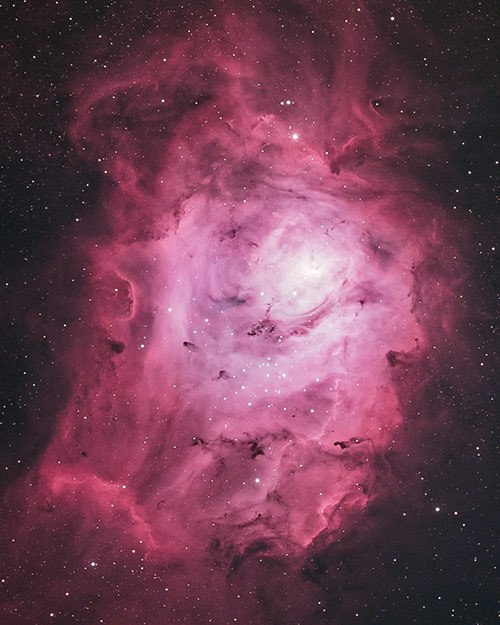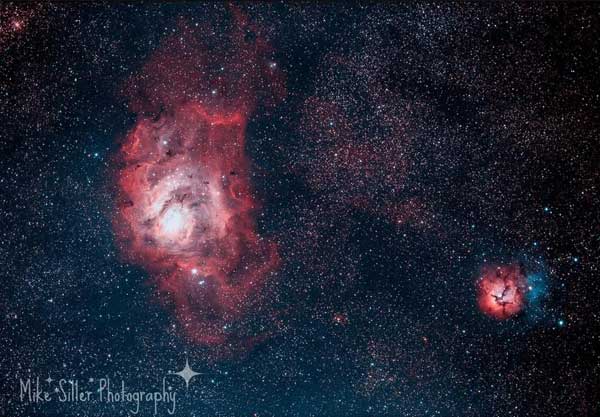The Lagoon Nebula
The Lagoon Nebula (Messier 8) is a bright emission nebula in the constellation Sagittarius. It is an active stellar nursery, an area of dust and gas in space where stars are formed.
It lies about 5,000 light-years away, near the center of our Milky Way Galaxy in the rich starfields of Sagittarius. The Lagoon Nebula includes an embedded open star cluster (NGC 6530) with hot stars that power the nebular glow.
M8 spans 33 light-years across and glows at a visual magnitude of 6. This makes this nebula an excellent choice for observation through an astronomical telescope or binoculars.
The Lagoon Nebula photographed using a color astronomy camera and telescope.
The Lagoon Nebula’s filaments of glowing gas and dark dust clouds make it a thrilling subject for deep-sky astrophotography with any camera and telescope.
This interstellar cloud of hydrogen gas gets its name from the dark lane that passes through the middle of the nebula like a sandbar. The bright outer regions on each side make it appear as if it were a lagoon.
In the Northern Hemisphere, the summer months of June through August are the best time to observe and photograph the Lagoon Nebula.
In the summer months, I enjoy taking a look at the Lagoon Nebula through the eyepiece of my 8″ Dobsonian telescope in the backyard. The Trifid Nebula is not far away, and the two deep-sky objects are some of the best nebulae to observe visually in the entire night sky.
In the photo below, you’ll see that the Lagoon Nebula lies within a concentrated area of the Milky Way core.
M8: The Lagoon Nebula
- Cataloged: Messier 8, M8, NGC 6523
- Type: Emission Nebula, H II Region
- Constellation: Sagittarius
- Distance to Earth: 4,077 light-years
- Magnitude: 6.0
- Distance: 4,100 ly (1,250 pc)
- Apparent dimensions (V): 90 × 40 arcmins
The Lagoon Nebula has the power to inspire others to get started in astrophotography. The bright colors and dynamic combination of stars and hydrogen gas in this emission nebula invoke emotions that few other deep sky objects can.
This target was the subject of my deep-sky image processing tutorial using Deep Sky Stacker and Adobe Photoshop.
Lagoon Nebula Location
It’s often easiest to locate the Teapot asterism in Sagittarius to find the Lagoon Nebula’s location in the night sky. Using a pair of binoculars, you’ll find M8 a few degrees above and to the right of the Teapot asterism.
Through binoculars or a telescope, the Lagoon Nebula will appear as a glowing “smudge”, and the details and shape of the nebula will depend on your viewing conditions. The Lagoon Nebula appears about 3 times the size of the full moon, the largest and brightest nebula in Sagittarius.
In the northern hemisphere, you can start looking for Messier 8 in the summer to early fall. July is usually the best month to see the Lagoon Nebula in the night sky.
The image above is a screenshot from the Stellarium Web online star map. To help you find the Lagoon Nebula and other deep-sky objects in the night sky, check out my list of the best stargazing apps for your mobile phone.
Due to the brightness of this object, it is one of the easiest nebulae to find in the night sky. If you can find the Teapot shape in Sagittarius, it won’t be long before you find the Lagoon Nebula.
Through a Telescope
The image below should give you an idea of what to expect when viewing the Lagoon Nebula through a telescope or a pair of binoculars. The brightness and detail observed will be determined by your viewing conditions.
An example of the Lagoon Nebula observed through a telescope (under ideal conditions).
The Lagoon Nebula is just barely visible to the unaided eye under good conditions. From my backyard, I can easily spot it in a pair of binoculars.
It is one of only two star-forming nebulae visible to the naked eye from mid-northern latitudes. Using binoculars or a small telescope, it will appear as a distinct oval cloudlike patch with a defined glowing core. The open cluster of stars (NGC 6530) can be seen within the nebula.
On a warm summer night, this is one of my favorite targets to observe using my Celestron SkyMaster 15 x 70 binoculars.
Astrophotography
I have photographed the Lagoon Nebula at high magnification using my camera and telescope many times.
The video below provides an inside look into what it is like to photograph deep-sky objects like the Lagoon Nebula through a telescope in my backyard.
For many deep-sky objects in the night sky, you must use a specific set of astrophotography equipment to capture them properly. This may be a specific narrowband filter or a long focal length optical instrument.
The Lagoon Nebula is not one of those targets. This nebula is extremely satisfying to photograph using nearly any camera, at any focal length. Even a wide-angle lens will show a noticeable pink glow in the vicinity of M8.
It is also bright enough to shine through a light-polluted city sky. Dim objects and small galaxies can be very challenging from the city, but this bright, large emission nebula is not.
In July 2017, I asked the members of the AstroBackyard Facebook community to share their photos of M8. Below you will find some excellent examples of the Lagoon Nebula using a camera lens or telescope.
Jeffrey Shokler
Total Exposure: 55 Minutes
Camera: Canon 5D Mark II (modified)
Telescope: Stellarvue 130EDT Refractor
Mike Siller
Total Exposure: Unspecified
Camera: Canon T5i (Full Spectrum Mod)
Telescope: Sky-Watcher 80ED
Kurt Zeppetello
Total Exposure: 1 Hour, 3 Minutes
Camera: Canon T3i (Modified)
Telescope: Orion ED80 f/7.5 Refractor
Alex Obrad
Total Exposure: 40 Minutes
Camera: Nikon D3
Telescope: Refractor Telescope (675mm focal length)
Victor Van Puyenbroeck
Total Exposure: 1 Hour, 12 Minutes
Camera: ZWO ASI1600MM-C
Telescope: TS 80 mm f/6 triplet APO
As you can see, no matter what camera, telescope, or camera lens you use, Messier 8 is a gorgeous subject. The images above should give you an idea of what to expect using an equatorial telescope mount and a variety of exposure lengths.









